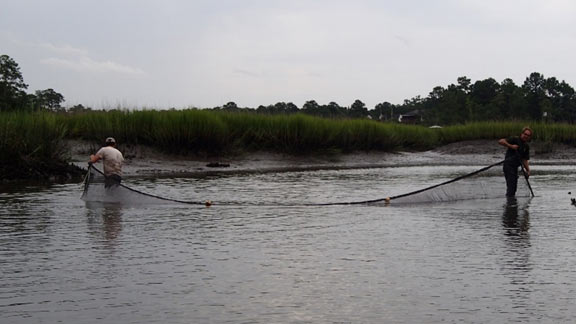Tidal Creeks - The Project
 The Tidal Creeks Project (TCP) was originally initiated in 1994 to understand how coastal development affects the environmental quality of headwater tidal creeks and salt marshes as well as to share project results with local and state land use planners and managers. Through the years, we have sampled over 50 creeks throughout the southeastern US which represent a wide range of development types including creeks with forested watersheds, suburban watersheds, urban watersheds, and industrial watersheds. The level of development has been described by the level of impervious surface or cover in the watershed. Impervious surfaces are is roofs, roads, parking lots, and other hard surfaces which do not allow water to penetrate into the ground. These impervious surfaces lead to stormwater runoff.
The Tidal Creeks Project (TCP) was originally initiated in 1994 to understand how coastal development affects the environmental quality of headwater tidal creeks and salt marshes as well as to share project results with local and state land use planners and managers. Through the years, we have sampled over 50 creeks throughout the southeastern US which represent a wide range of development types including creeks with forested watersheds, suburban watersheds, urban watersheds, and industrial watersheds. The level of development has been described by the level of impervious surface or cover in the watershed. Impervious surfaces are is roofs, roads, parking lots, and other hard surfaces which do not allow water to penetrate into the ground. These impervious surfaces lead to stormwater runoff.
Results from our previous sampling efforts has found that the amount and type of watershed development (impervious cover) was linked to impairment of water quality including increased fecal coliform levels and nutrient loadings, decreased sediment quality, changes in the kinds and abundances of macrobenthos, changes in the abundance of juvenile fish, and decreases in the abundance of shrimp that use these tidal creek headwaters as nurseries. The relationships were strongest in the headwater areas. Headwater areas were identified as the “first responders” to non-point source pollution runoff and characterized as a sentinel habitat for assessing the impacts of coastal development. Based on these relationships, it is possible to use simple linear relationships to forecast the likely effects that increasing impervious cover may have on critical indicators of the ecosystem and public health.
These relationships led us to ask the following question - Are the relationships observed a direct cause of coastal development? The robust data that are available from TCP starting in 1994 provides a unique opportunity to revisit a number of these systems that have been further development to begin to answer the question as to whether coastal development has caused the system-level changes observed. A number of the systems originally sampled have increased levels of development in their watersheds. For example, many of the undeveloped, forested watersheds originally sampled are now suburban environments. In addition, many of the undeveloped, forested creek watersheds which have been developed since 1994 when Best Management Practices (BMP), primarily stormwater ponds, were required. The overall goal of the current project is to assess and refine the existing models relating the environmental quality in tidal creeks to their surrounding land use over a 20 year period.

